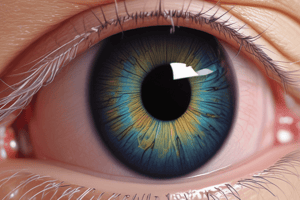Podcast
Questions and Answers
What condition is characterized by irregular astigmatism affecting younger individuals?
What condition is characterized by irregular astigmatism affecting younger individuals?
- Corneal scarring
- Keratoconus (correct)
- Postrefractive surgery ectasia
- Pellucid marginal degeneration
Corneal crosslinking (CXL) has universally positive outcomes for all pediatric cases of keratoconus.
Corneal crosslinking (CXL) has universally positive outcomes for all pediatric cases of keratoconus.
False (B)
What is the gold standard treatment when refractive correction is no longer possible due to severe irregular astigmatism?
What is the gold standard treatment when refractive correction is no longer possible due to severe irregular astigmatism?
Penetrating keratoplasty
What is the primary purpose of applying riboflavin solution to the de-epithelized cornea?
What is the primary purpose of applying riboflavin solution to the de-epithelized cornea?
Transepithelial cross-linking (CXL) is an older technique compared to conventional CXL.
Transepithelial cross-linking (CXL) is an older technique compared to conventional CXL.
The incidence of keratoconus (KC) is estimated to be 1 in _______.
The incidence of keratoconus (KC) is estimated to be 1 in _______.
What is the recommended power of UVA light exposure during the riboflavin treatment?
What is the recommended power of UVA light exposure during the riboflavin treatment?
Which treatment has been proposed to address thin corneas that are not candidates for CXL?
Which treatment has been proposed to address thin corneas that are not candidates for CXL?
Match the following treatments or conditions with their descriptions:
Match the following treatments or conditions with their descriptions:
The corneal epithelium is typically removed mechanically with a __________.
The corneal epithelium is typically removed mechanically with a __________.
What can be used to correct vision in the initial stages of keratoconus?
What can be used to correct vision in the initial stages of keratoconus?
What complication can arise after de-epithelizing the cornea?
What complication can arise after de-epithelizing the cornea?
Match the treatment with its associated effect:
Match the treatment with its associated effect:
Photosynthetic pigments have been shown to increase corneal stiffness when excited with near-infrared illumination.
Photosynthetic pigments have been shown to increase corneal stiffness when excited with near-infrared illumination.
The study conducted by Stulting et al. involved 512 eyes of patients with ________.
The study conducted by Stulting et al. involved 512 eyes of patients with ________.
What is the minimum corneal thickness that should be obtained before considering treatment?
What is the minimum corneal thickness that should be obtained before considering treatment?
What is a risk factor for progression following corneal collagen crosslinking (CXL)?
What is a risk factor for progression following corneal collagen crosslinking (CXL)?
Dry eye symptoms can worsen after CXL treatment due to abnormal nerve migration.
Dry eye symptoms can worsen after CXL treatment due to abnormal nerve migration.
What does CXL stand for in the context of ophthalmology?
What does CXL stand for in the context of ophthalmology?
Corneal subepithelial nerve fibers are affected following _____ treatment.
Corneal subepithelial nerve fibers are affected following _____ treatment.
Match the studies with their findings related to corneal collagen crosslinking:
Match the studies with their findings related to corneal collagen crosslinking:
After how long did one study observe complete regeneration of corneal subepithelial nerve fibers following CXL treatment?
After how long did one study observe complete regeneration of corneal subepithelial nerve fibers following CXL treatment?
Progression in abnormal nerve migration can be observed for up to 5 years after CXL treatment.
Progression in abnormal nerve migration can be observed for up to 5 years after CXL treatment.
How long after CXL treatment did early regeneration of corneal subepithelial nerve fibers occur according to a study?
How long after CXL treatment did early regeneration of corneal subepithelial nerve fibers occur according to a study?
What is the focus of the study by Ng et al. in 2021?
What is the focus of the study by Ng et al. in 2021?
Corneal collagen crosslinking is effective for treating infectious keratitis.
Corneal collagen crosslinking is effective for treating infectious keratitis.
What technique is used in the study by Cherfan et al. to increase corneal stiffness?
What technique is used in the study by Cherfan et al. to increase corneal stiffness?
The study conducted by Martinez et al. in 2020 focused on cross-linking-assisted infection reduction in _____ keratitis.
The study conducted by Martinez et al. in 2020 focused on cross-linking-assisted infection reduction in _____ keratitis.
Which of the following studies evaluates the cellular and molecular effects of rose Bengal photodynamic antimicrobial therapy?
Which of the following studies evaluates the cellular and molecular effects of rose Bengal photodynamic antimicrobial therapy?
Match the authors with their respective studies:
Match the authors with their respective studies:
Which study discusses the use of the bacteriochlorophyll derivative WST11?
Which study discusses the use of the bacteriochlorophyll derivative WST11?
Data sharing was applicable in all studies mentioned.
Data sharing was applicable in all studies mentioned.
What is the purpose of corneal collagen cross-linking (CCL)?
What is the purpose of corneal collagen cross-linking (CCL)?
Collagen cross-linking is only used in adult patients.
Collagen cross-linking is only used in adult patients.
What technique can be used alongside collagen cross-linking for keratoconus?
What technique can be used alongside collagen cross-linking for keratoconus?
Collagen cross-linking is effective in treating ____________ degeneration.
Collagen cross-linking is effective in treating ____________ degeneration.
Match the following outcomes with their corresponding study:
Match the following outcomes with their corresponding study:
Which of the following is a review article about patient selection for corneal collagen cross-linking?
Which of the following is a review article about patient selection for corneal collagen cross-linking?
All studies agree on the same measurement techniques for evaluating outcomes after CCL.
All studies agree on the same measurement techniques for evaluating outcomes after CCL.
What procedure was performed alongside collagen cross-linking in the Athens protocol?
What procedure was performed alongside collagen cross-linking in the Athens protocol?
Study Notes
Corneal Cross-Linking (CXL) Procedure
- The central corneal epithelium, measuring 9 mm, can be mechanically removed through various methods, including debridement with specialized tools.
- Riboflavin solution (0.1% riboflavin in 20% dextran) is applied to the de-epithelialized cornea for 30 minutes before exposure to UVA light (370 nm).
- UVA exposure is conducted at a power of 3 mW/cm2 for a duration of 30 minutes, with riboflavin solution applied every 2-5 minutes during the process.
- Potential complications from de-epithelialization include corneal haze and pain; a bandage contact lens is often used postoperatively for pain management.
Importance of Riboflavin and Corneal Thickness
- Riboflavin serves as a crucial agent for enhancing corneal stiffness and is subject to penetration limitations due to the epithelium acting as a barrier.
- Ultrasound pachymetry can assess corneal thickness and determine suitability for CXL; a minimum corneal thickness of 400 µm is preferred.
- For corneas thinner than 400 µm, hypotonic riboflavin ophthalmic solution can be used to ensure adequate riboflavin absorption.
Transepithelial CXL (Epi-On)
- Transepithelial CXL is a less invasive alternative that promotes faster healing, improved comfort, and a reduced risk of corneal haze.
- Clinical studies have shown significant improvements in visual acuity and decreased keratometric values after CXL treatment.
Keratoconus (KC) Details
- Keratoconus is a common form of spontaneous corneal ectasia occurring predominantly in younger individuals, with an estimated incidence of 1 in 2000.
- Initial treatment often involves rigid gas permeable or scleral lenses; penetrating keratoplasty is considered the gold standard in cases of severe irregular astigmatism.
Pediatric Population Considerations
- The efficacy of CXL in children (ages 9-18) for keratoconus remains debated; some studies show improvement while others report worsening of corneal thickness.
- The Siena Pediatrics CXL study, a significant study with 152 KC patients aged 10-18, gives insights into long-term outcomes post-treatment.
Risks and Complications
- Risks associated with CXL treatment include corneal haze, changes in corneal shape, and potential for disease progression or flattening.
- Steeper Kmax preoperatively may indicate a higher risk of progression after CXL.
Dry Eye and Nerve Damage
- CXL affects corneal subepithelial nerve fibers, with early regeneration observed within the first month, though symptoms of dry eye may persist.
- Long-term neuropathic symptoms can develop, impacting patient comfort.
Innovative Treatment Strategies
- Prophylactic and simultaneous treatments are being explored to improve corneal stiffness without the drawbacks associated with traditional CXL, especially in thin corneas.
- Recent advancements include the use of photosynthetic pigments and novel formulations to enhance treatment outcomes.
Summary of Findings
- Visual acuity improved by 1–1.5 Snellen lines after 1–2 years post-CXL, with a decrease in mean Kmax measurements.
- The approach must balance effectiveness with patient comfort and potential complications, requiring careful patient selection and monitoring.
Studying That Suits You
Use AI to generate personalized quizzes and flashcards to suit your learning preferences.
Related Documents
Description
This quiz covers the methods of mechanically removing the central corneal epithelium and the subsequent application of riboflavin solution. It highlights various techniques such as using a blunt hockey knife and transpethelial phototherapeutic approaches. Test your knowledge on the procedures involved in corneal treatment.




